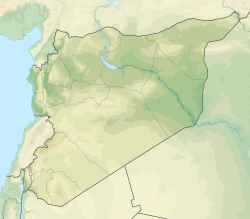Top Qs
Timeline
Chat
Perspective
Freedom Dam
Dam in Raqqa Governorate, Syria From Wikipedia, the free encyclopedia
Remove ads
The Freedom Dam (Arabic: سد الحرية, Kurdish: Bendava Azadî, Classical Syriac: ܣܟܪܐ ܕܚܐܪܘܬܐ, romanized: Sekro d'Ḥirutho), formerly the Baath Dam, is a dam on the Euphrates, located 22 kilometres (14 mi) upstream from the city of Raqqa in Raqqa Governorate, Syria. Construction of the dam started in 1983 and was finished in 1986. It is intended to generate hydroelectric power as well as regulate the irregular flow from the Tabqa Dam, which is located 18 kilometres (11 mi) upstream from the Freedom Dam. These irregularities in the flow from the Tabqa Dam are caused by changes in the electricity demand.[1] The Freedom Dam is 14 metres (46 ft) high and the installed water turbines can generate 81 MW. The storage capacity of the Freedom Dam Reservoir is 0.09 cubic kilometres (0.022 cu mi).[2]
The Freedom Dam is one of three dams on the Syrian Euphrates, the other two being the Tabqa Dam, and the Tishrin Dam 80 kilometres (50 mi) south of the Syria-Turkish border. Like the Baath Dam, the Tishrin Dam is also functionally related to the Tabqa Dam. Construction of the Tishrin Dam was partly motivated by the disappointing performance of the hydroelectric power station in the Tabqa Dam.[3] Before the Syrian Civil War, Syria had plans to construct a fourth dam – the Halabiye Dam – on the Euphrates, downstream from the Freedom Dam.[4] Before its renaming to the Freedom Dam, the dam was named after the Syrian Arab Socialist Ba'ath Party.[5]
Remove ads
Syrian Civil War
On 4 February 2013, opposition forces captured the dam, a week before capturing the Tabqa Dam.[6][7] The Baath Dam was captured from the ISIL by the Syrian Democratic Forces on 4 June 2017. Upon doing so, they renamed it the "Freedom Dam" (Kurdish: Bendava Azadî; Arabic: سد الحرية; Classical Syriac: ܣܟܪܐ ܕܚܐܪܘܬܐ, romanized: Sekro d'Ḥirutho).[8] ISIL used the complex as a prison.[9] In 2019, control of the dam was given to the Syrian government after the Turkish invasion of Northern Syria.[5]
Remove ads
See also
Notes
References
Wikiwand - on
Seamless Wikipedia browsing. On steroids.
Remove ads


